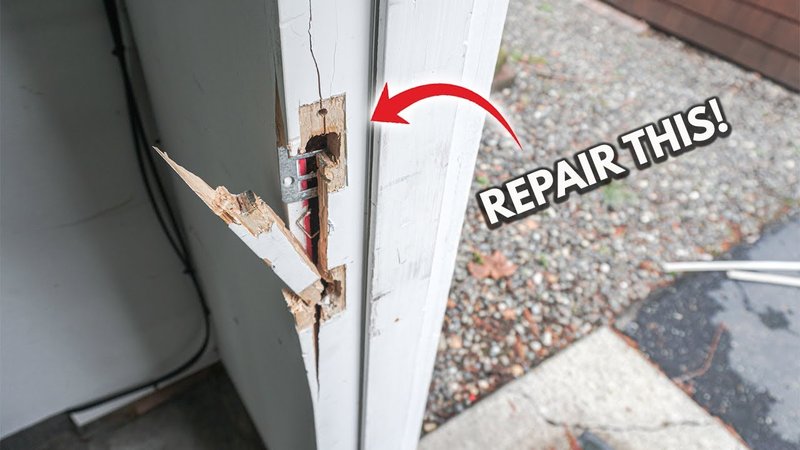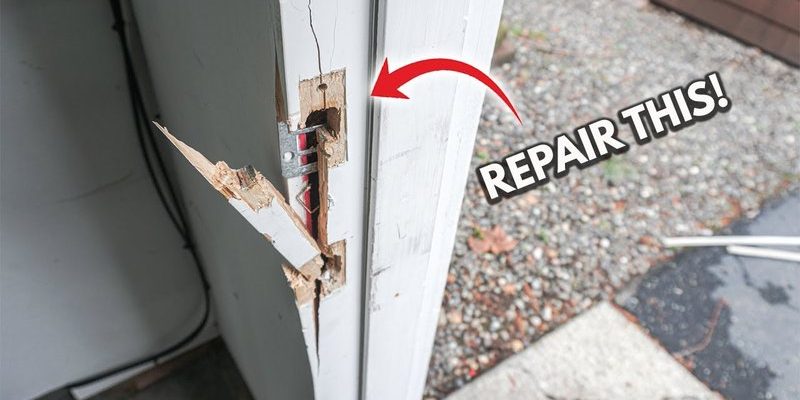
If you’ve got a Marvin exterior door or something similar from another well-known brand, you might notice the problem most when you go to latch or lock the door. Sometimes, it feels like the hardware was installed wrong or has been knocked out of place, but here’s the thing: the squareness of the door frame usually calls the shots. Even if you’ve got the best lock and handle on the market, none of it will work smoothly if your door frame isn’t actually square.
Below, I’ll walk you through what causes these issues, how hardware factors in, and what you can do—even if you’re new to home repairs. Let’s break it down step by step, keeping things as simple as possible.
How to Tell If Your Door Frame Is Out of Square
When you’re troubleshooting an exterior door that’s acting up, it’s easy to blame squeaky hinges, a stubborn lock, or even the weather. But none of those problems compare to a door frame that’s not actually square with the wall. So how do you spot the problem? Here’s what to look for:
- Uneven Gaps: Check the gap between the door and the frame on every side. If it’s wider at the top than the bottom (or vice versa), that’s your first hint.
- Sticking or Rubbing: If you find yourself shoving the door to get it to close or it scrapes the floor, the frame is likely out of alignment.
- Hardware Issues: Latch and strike plates often don’t line up when the frame is off. You’ll see handles that rattle, locks that won’t engage, or deadbolts that barely slide in.
Honestly, a quick visual inspection can tell you a lot. Open and close the door a few times and watch how everything moves. If the top corner catches or the handle feels “off,” your frame is probably guilty as charged.
Why Door Frame Squareness Matters for Hardware
Let me explain why a square door frame is such a big deal—especially for your hardware. Every piece of hardware on your door—hinges, handles, locks, latches—depends on precise alignment. When the frame goes crooked, everything else gets thrown off, like trying to sync a remote to the wrong TV input.
Here’s how it plays out:
- Locks Won’t Latch: If the frame twists, the bolt on your deadbolt won’t meet the strike plate cleanly. You end up fiddling with the key or forcing the door, which can wear out the mechanism.
- Hinges Get Stressed: Hardware screws may start to loosen or strip out as the door drags or resists movement. Over time, this makes the problem even worse.
- Weatherstripping Stops Working: When frames aren’t square, the seals don’t line up, leading to drafts and leaks. Marvin doors—or really any good exterior door—lose their expensive weather benefits if the frame’s off-kilter.
A not-square frame sets off a domino effect of hardware headaches. These issues don’t fix themselves—if anything, they get worse every time you use the door.
Common Causes of a Non-Square Exterior Door Frame
You might be wondering: why does a door frame go out of square in the first place? Sometimes, it’s not your fault at all. Houses settle, weather happens, and materials expand or contract. Here’s what usually goes wrong:
- Foundation Shifts: Over time, your house settles. This can lift one side of the door frame, nudging it out of square.
- Water Damage: If water gets into the wood around the door, the frame can swell, rot, or warp. You’ll see more of this in older homes or places with heavy rain.
- Poor Installation: Sometimes, the frame was never square to start with. Builders in a rush (or DIY mistakes) can set you up for years of annoying hardware problems.
- Temperature Changes: Wood expands with humidity and contracts when it’s dry. This seasonal movement messes with even top-quality frames like those from Marvin.
Spotting which of these issues caused your problem can guide how you fix it. Sometimes, you’ll need to address the underlying problem (like sealing out water) before you can square up the frame for good.
Step-by-Step: Squaring Up a Crooked Door Frame
If you’re ready to roll up your sleeves, realigning a door frame isn’t as scary as it sounds. Here’s a slow walk through what you’ll want to do:
- Remove the Door and Hardware: Take the door off its hinges. Remove the handles, locks, and strike plates. This makes everything easier to adjust and keeps your hardware safe.
- Check the Frame with a Level and Square: Place a carpenter’s level along the sides and top of the frame. Then use a framing square in the corners. Note where things are out of alignment—maybe the bottom hinge side is kicked out or the top isn’t straight.
- Shim or Adjust as Needed: Use wooden shims behind the door frame to push or pull it into a square position. You may need to loosen screws or nails to make room for the shims. Tap them in gently; check with your level and square until it’s right.
- Secure the Frame: Once you’ve got it as square as possible, screw or nail the frame back in place. Avoid overtightening, which can pull things back out of shape.
- Reinstall Hardware and Door: Put everything back where it was, starting with the hinges. Hang the door, check the fit, and try closing it. Make sure the lock hardware lines up perfectly with the strike plate.
If you’re dealing with a heavy, solid Marvin exterior door, you might want a second person to help with the lifting. Take your time—rushing can undo all your careful adjustments.
How Hardware Impacts and Reacts to Frame Alignment
You might think that if the hardware looks fine, the frame can’t be that bad. But honestly, the hardware is where many problems start—or at least, where you notice them first. Here’s what happens:
- Hinges: If the frame’s off, hinges bear extra weight and twist. Screws can loosen, holes can enlarge, and eventually, the door might sag or even rip out of the wood.
- Latch and Lock Sets: Off-kilter frames make the latch miss the strike plate. You’ll need to slam the door or jiggle the handle. Over time, this can wear out springs and break components inside the lock.
- Deadbolt Alignment: Marvin and other premium doors use sturdy deadbolts, but if alignment is off, you’ll end up with a deadbolt that doesn’t fully engage—a big security concern.
Sometimes people try to fix the symptom instead of the cause, moving strike plates or filing down the door. But these fixes are like using a universal remote on a TV with no signal—they might help a little, but the real fix is getting your frame back to square.
Should You Replace or Repair the Hardware?
After squaring your frame, it’s smart to double-check the hardware itself. Hardware can get bent, stripped, or otherwise damaged while the frame was crooked. Here’s what to consider:
- Screws: If screws are stripped, replace them with longer ones or beefier types for a better hold.
- Strike Plates: If the latch still misses the strike plate, adjust its position. Fill old screw holes with wood filler for a fresh start, then drill new pilot holes as needed.
- Lock Sets: If locks or handles feel loose or sticky, consider a replacement. Syncing up a new handle or deadbolt to a newly squared door can make everything feel brand new.
If you’re already replacing hardware, now’s a good time to upgrade. Modern lock sets, especially for Marvin or similar exterior doors, often come with better weatherstripping or anti-tamper features. It’s worth the extra effort for peace of mind.
Comparing DIY Fixes and When to Call a Pro
For many folks, this repair is doable with patience, basic tools, and a good set of instructions. But sometimes, things get complicated—especially with old houses, severe water damage, or very expensive doors.
You might want to call in a pro if:
- The frame is rotted or falling apart. No amount of shimming will fix decayed wood; you’ll need a full replacement.
- You see major cracks around the door or in the wall. This could mean bigger structural problems that go beyond a wonky door frame.
- Custom or oversized Marvin doors. These are heavy and expensive. If you’re not confident, let a licensed installer handle it.
Otherwise, most handy homeowners can handle a minor squaring job and hardware reset with a steady hand and time.
Maintenance Tips to Keep Your Door Frame Square
Once you’ve conquered the crooked frame, a little routine care helps keep it square—and your hardware trouble-free. Here’s what I recommend:
- Check for Drafts: Every season, run your hand around the closed door. Feeling cold air? Time to check alignment and seals.
- Tighten Screws: Give your hinges, lock sets, and strike plates a quick inspection and tighten any loose screws.
- Seal Out Water: Make sure caulking and weatherstripping are in good shape, especially if you’ve got a wood frame. Water is a frame’s worst enemy.
- Lubricate Moving Parts: A little graphite or silicone spray keeps locks and latches working smoothly after syncing up your hardware.
Small checks every few months go a long way toward preventing bigger problems later.
Any time your door hardware starts acting up, don’t just reset or replace—check the frame first. It’s almost always the root of the problem.
Wrapping Up: Get Your Door (and Your Sanity) Back on Track
Dealing with an exterior door frame that’s not square can feel like trying to troubleshoot a remote that just won’t pair with its device—frustrating until you actually fix what’s wrong. The good news? With a bit of patience, some basic tools, and attention to both the frame and hardware, you can get things lined up again. Your Marvin door (or any exterior door, really) will work smoothly, keep you safe, and make everyday life feel a whole lot less irritating.
Remember, fixing the frame and syncing your hardware isn’t just about looks—it’s about keeping out the weather, staying secure, and making your home feel right. And if things ever get too wild, there’s no shame in calling in a pro. Here’s to doors that close easily and hardware that finally works the way it should.
